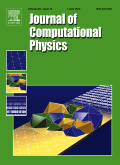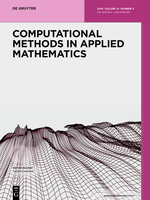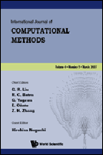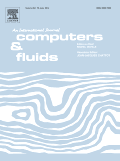
JOURNAL OF COMPUTATIONAL PHYSICS
Scope & Guideline
Unveiling New Dimensions in Applied Mathematics
Introduction
Aims and Scopes
- Numerical Methods and Algorithms:
The journal emphasizes the development of advanced numerical methods, including finite element, finite volume, and spectral methods, aimed at solving complex partial differential equations that govern physical phenomena. - High-Order Accuracy and Stability:
A significant focus is on high-order methods that ensure accuracy and stability in simulations, especially for hyperbolic and parabolic equations, with applications in fluid dynamics and wave propagation. - Multiscale and Multiphysics Problems:
Research often addresses multiscale and multiphysics challenges, integrating different physical models and computational approaches to provide comprehensive solutions to complex real-world problems. - Data-Driven and Machine Learning Approaches:
The integration of machine learning techniques with traditional computational methods is a growing area of interest, aimed at enhancing predictive capabilities and efficiency in simulations. - Uncertainty Quantification and Sensitivity Analysis:
The journal also includes studies on uncertainty quantification in simulations, ensuring robustness and reliability in computational predictions under varying parameters and conditions. - Applications in Engineering and Natural Sciences:
Research published spans applications in engineering disciplines such as aerospace, mechanical, and civil engineering, as well as in natural sciences, particularly in fluid mechanics and materials science.
Trending and Emerging
- Physics-Informed Machine Learning:
There is a significant increase in the application of physics-informed machine learning techniques, which combine traditional numerical methods with machine learning to enhance predictive accuracy and modeling efficiency. - Adaptive Mesh Refinement Techniques:
Research has increasingly focused on adaptive mesh refinement methods, which allow for more efficient simulations by dynamically adjusting the computational grid based on the solution features. - Multiscale Modeling Approaches:
Emerging themes include the development of multiscale models that can effectively bridge different physical scales, providing more accurate representations of complex phenomena. - Hybrid Computational Techniques:
The trend of combining different numerical techniques, such as lattice Boltzmann and finite element methods, is on the rise, aiming to leverage the strengths of each method for better simulation outcomes. - Uncertainty Quantification and Robustness:
An increasing number of studies are dedicated to uncertainty quantification in computational models, addressing the need for robust solutions in the face of parameter variability and model uncertainties. - Complex Fluid Dynamics and Multiphase Flows:
There is a growing focus on complex fluid dynamics and multiphase flow problems, highlighting the need for advanced modeling techniques to capture intricate interactions in various applications.
Declining or Waning
- Traditional Finite Difference Methods:
There has been a noticeable decline in papers focused solely on traditional finite difference methods, possibly due to the emergence of more sophisticated techniques such as high-order and adaptive methods that offer better accuracy and efficiency. - Basic Lattice Boltzmann Models:
The use of basic lattice Boltzmann methods has decreased, likely as researchers move towards more complex and hybrid models that incorporate additional physics, such as multiphase flows and non-Newtonian effects. - Single-Phase Fluid Dynamics:
There appears to be a waning interest in studies exclusively dedicated to single-phase fluid dynamics, as the field increasingly incorporates multiphase interactions and complex fluid-structure interactions. - Low-Order Approximations:
Research focusing on low-order numerical approximations is declining, as there is a growing emphasis on high-order methods that can better capture the dynamics of complex systems.
Similar Journals

JOURNAL OF COMPUTATIONAL MATHEMATICS
Fostering Collaboration for Mathematical ExcellenceJOURNAL OF COMPUTATIONAL MATHEMATICS, published by GLOBAL SCIENCE PRESS, is a distinguished peer-reviewed academic journal dedicated to advancing the field of computational mathematics. With a focus on high-quality research that bridges theoretical and practical applications, this journal aims to disseminate innovative methodologies and robust algorithms that address complex mathematical problems. Operating without an open-access model, it maintains a reputable standing with a Q2 category classification in computational mathematics as of 2023, showcasing its influence and relevance within the academic community. The journal, which has been in publication since 1996, continues to evolve, providing a platform for researchers, practitioners, and students to engage with cutting-edge developments up to 2024. By contributing to the body of knowledge in computational mathematics, this journal plays a vital role in fostering collaboration and advancement in related disciplines.

Computational Methods in Applied Mathematics
Navigating the Future of Mathematics with Computational PrecisionComputational Methods in Applied Mathematics is a premier academic journal published by WALTER DE GRUYTER GMBH, based in Germany. With its ISSN 1609-4840 and E-ISSN 1609-9389, this journal serves as a crucial platform for the dissemination of cutting-edge research and innovations in the fields of Applied Mathematics, Computational Mathematics, and Numerical Analysis. Notably, it has been recognized in 2023 with a Q2 ranking in its category quartiles, marking it as a significant contributor in its discipline. Spanning from 2001 to 2024, it fosters interdisciplinary collaboration and exploration of computational methodologies that solve complex mathematical problems. Though it operates on a traditional access model, its relevance is underscored by its Scopus rankings, which place it among the notable leaders in its area. As a trusted source of scholarly articles, Computational Methods in Applied Mathematics is an essential resource for researchers, professionals, and students aiming to stay abreast of advancements and discussions that shape the future of applied mathematics.

FINITE ELEMENTS IN ANALYSIS AND DESIGN
Transforming analysis into design excellence.FINITE ELEMENTS IN ANALYSIS AND DESIGN, published by Elsevier, is a leading international journal dedicated to advancing the field of engineering analysis using finite element techniques. With a strong focus on theoretical and applied contributions, the journal spans a broad spectrum of subjects, including structural analysis, computational mechanics, and computer graphics applications, making it an essential resource for researchers, professionals, and students alike. As evidenced by its impressive Q1 ranking in multiple categories, including Analysis and Computer Graphics, and its Scopus rankings placing it in the top 10% across several fields, it serves as a vital platform for disseminating cutting-edge research and innovative applications within the field. The journal, with an ISSN of 0168-874X and an E-ISSN of 1872-6925, publishes articles that emphasize rigorous mathematical methodologies and computational advancements, ensuring high relevance for contemporary engineering challenges. With a history extending from 1985 to 2024, it continues to shape the discourse and progress within the finite element community.

International Journal of Computational Methods
Pioneering research that bridges disciplines and drives innovation.The International Journal of Computational Methods is a premier academic journal dedicated to advancing the field of computational mathematics and its applications in various domains of computer science. Published by WORLD SCIENTIFIC PUBL CO PTE LTD, this journal serves as a critical platform for researchers and practitioners to disseminate innovative computational techniques and methodologies that address complex problems in science and engineering. With a significant focus on fostering interdisciplinary collaboration, the journal is essential for those looking to explore cutting-edge topics in computational methods. Established in 2006 and spanning until 2024, it holds respectable rankings in Q3 for Computational Mathematics and Q2 for Miscellaneous Computer Science as of 2023, reflecting its growing impact in the academic community. Although the journal is not currently open access, it offers various subscription options to enable access to its high-quality research articles. By bridging theoretical advancements and practical implementations, the International Journal of Computational Methods plays a vital role in shaping future innovations within both academic and industrial settings.

ADVANCES IN COMPUTATIONAL MATHEMATICS
Exploring New Frontiers in Applied Computational TechniquesADVANCES IN COMPUTATIONAL MATHEMATICS, published by Springer, is a leading international journal dedicated to the dynamic and rapidly evolving fields of Applied Mathematics and Computational Mathematics. With an impressive Q1 ranking in both categories as of 2023, the journal serves as a vital platform for researchers and professionals to disseminate innovative methodologies and computational techniques that address complex mathematical challenges. Operating since 1993 and continuing to contribute substantially to the academic landscape through 2024, it boasts a robust reputation within the mathematics community, underscored by its Scopus rankings—#230 out of 635 in Applied Mathematics and #80 out of 189 in Computational Mathematics. This journal, based in the Netherlands, emphasizes cutting-edge research while offering a wealth of access options to facilitate scholarly communication. As such, ADVANCES IN COMPUTATIONAL MATHEMATICS stands as an essential resource for anyone interested in the forefront of computational techniques and mathematical theory.

ESAIM-Mathematical Modelling and Numerical Analysis
Advancing Mathematical Frontiers with PrecisionESAIM-Mathematical Modelling and Numerical Analysis, published by EDP SCIENCES S A, is a prestigious open-access journal at the forefront of the fields of mathematical analysis, applied mathematics, computational mathematics, modeling, simulation, and numerical analysis. With an impressive Q1 ranking in multiple categories for 2023, the journal is recognized for its contribution to advanced research, particularly in areas that intertwine mathematical theory with practical applications. The journal’s ISSN is 2822-7840 and its E-ISSN is 2804-7214, showcasing its commitment to both traditional and digital dissemination of knowledge. Spanning from 1996 to 2024, ESAIM has established itself as a vital platform for scholars seeking to publish innovative research and engage with the latest advancements in the field. Researchers and practitioners can explore the journal’s content through various access options, fostering a collaborative environment for the sharing and development of new mathematical methodologies. Situated in France, ESAIM continues to attract an international readership, driving forward the global discourse in mathematical sciences.

COMPUTERS & FLUIDS
Bridging Theory and Application in Fluid Dynamics ResearchCOMPUTERS & FLUIDS, published by PERGAMON-ELSEVIER SCIENCE LTD, is a premier journal in the fields of Computer Science and Engineering, with a distinguished history dating back to 1973. Its Q1 ranking in both Computer Science (Miscellaneous) and Engineering (Miscellaneous) illustrates its high impact and relevance, being positioned among the top tier of scientific publications. With a robust focus on the intersection of computational methods and fluid dynamics, this journal serves as a vital platform for researchers, professionals, and students dedicated to advancing knowledge and technology within these domains. Although it is not an open-access journal, its articles are accessible through various academic institutions and libraries, ensuring that vital research reaches its intended audience. Readers can explore innovative methodologies and applications, reinforcing the journal's commitment to enhancing the understanding of fluid mechanics through cutting-edge computational approaches. For more details, visit the official website of COMPUTERS & FLUIDS to stay abreast of the latest research advancements.

Advances in Applied Mathematics and Mechanics
Unveiling Insights in Mathematics and Mechanical EngineeringAdvances in Applied Mathematics and Mechanics is a premier academic journal published by GLOBAL SCIENCE PRESS that focuses on the latest research and innovative developments in the fields of applied mathematics and mechanical engineering. Since its inception in 2009, this journal has consistently contributed to the advancement of knowledge, garnering a respectable Q2 ranking in both Applied Mathematics and Mechanical Engineering categories, reflecting its significance in enhancing scientific discourse. With an impactful reach, as evidenced by its Scopus rankings, this journal hosts cutting-edge research, theoretical advancements, and practical applications that serve as invaluable resources for researchers, professionals, and students alike. While it operates under a subscription model, the accessibility of vital research findings is critical for driving innovation within these interrelated disciplines. The journal’s scope encompasses a broad range of topics, from computational methods to engineering applications, positioning it as a crucial platform for interdisciplinary collaboration and knowledge sharing in an ever-evolving academic landscape. For prospective authors and readers, Advances in Applied Mathematics and Mechanics stands as a key contributor to confidently navigating the nexus of applied mathematics and mechanics.

International Journal of Numerical Analysis and Modeling
Connecting Researchers and Practitioners in AnalysisThe International Journal of Numerical Analysis and Modeling, published by ISCI-INST SCIENTIFIC COMPUTING & INFORMATION, is a leading platform for research in the field of numerical analysis. With an ISSN of 1705-5105 and an E-ISSN of 1705-5105, this esteemed journal has been disseminating rigorous and innovative studies since its inception in 2004. Covering a diverse range of topics within numerical analysis, it has successfully positioned itself in Q2 of the 2023 category quartiles and ranks 46th out of 88 in its Scopus classification, showcasing its relevance and impact within the academic community. Operating under an open access model, it ensures that research findings are accessible to a global audience, fostering collaboration and knowledge exchange. Based in Canada, this journal not only highlights advancements in computational methodologies but also addresses real-world applications, bridging theoretical frameworks with practical solutions. Researchers, professionals, and students alike will find valuable insights and up-to-date contributions in this crucial field of study.

Applications of Mathematics
Transforming Ideas into Mathematical SolutionsApplications of Mathematics, published by SpringerNature, is a respected journal based in the Netherlands that provides a platform for innovative research in the field of applied mathematics. Since its inception in 1997 and with a convergence ongoing until 2024, the journal supports the dissemination of high-quality scholarship, although it currently holds a Q4 category ranking in the applied mathematics category, which reflects its niche importance in the academic community. Researchers and professionals in the field can access a diverse array of applied mathematical techniques and their practical applications, contributing to advancements across various disciplines. While the journal does not operate under an open access model, it is indexed and ranked in Scopus, where it holds a rank of 419 out of 635, placing it in the 34th percentile. This underscores its value and relevance in the global research landscape.